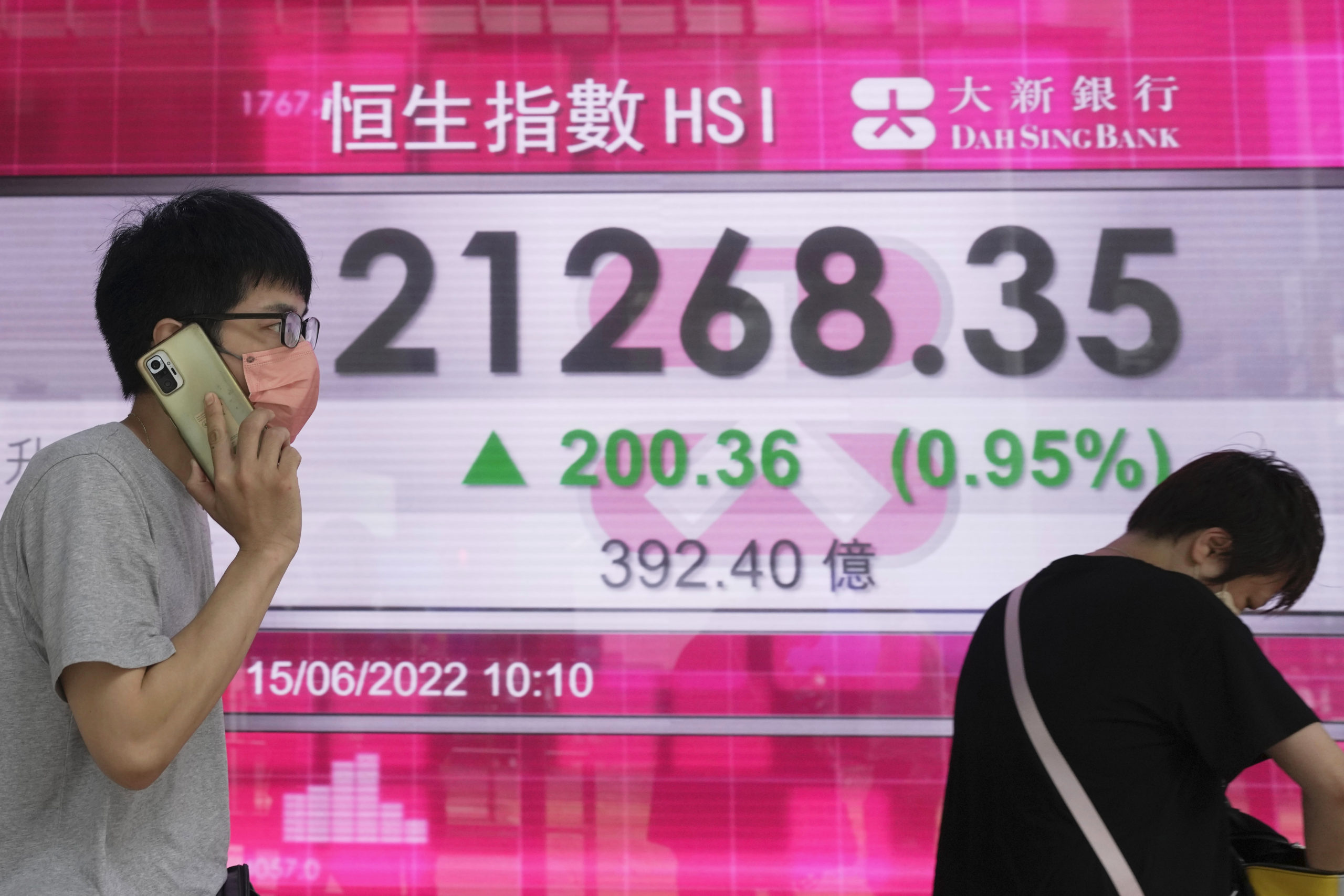TOKYO (AP) — Asian shares advanced Thursday after the Federal Reserve raised its key interest rate by three-quarters of a point and signaled more rate hikes were coming to fight inflation.
Wall Street rallied Wednesday after the Fed’s hike, the biggest since 1994, as investors took heart from Chair Jerome Powell’s comments suggesting future rate increases may be more modest. The bigger than usual rate hike also had been anticipated for weeks and came as no surprise.
The Bank of Japan is holding a two-day policy meeting, starting Thursday. The Japanese central bank is under pressure to act given downward pressures on the yen from U.S. rate hikes and super-low rates in Japan.
Investors have been selling yen and buying dollars in anticipation of higher yields from dollar-denominated holdings. Japanese politicians and the central bank chief have expressed worries about the declining yen, but no dramatic policy changes are expected.
Early Thursday, the U.S. dollar edged up to 134.56 Japanese yen from 133.82 yen. It recently topped 135 yen, the highest level in 20 years. The euro cost $1.0438, down from $1.0447.
Japan’s benchmark Nikkei 225 surged 1.8% in morning trading to 26,793.19. Australia’s S&P/ASX 200 gained 0.4% to 6,627.50. South Korea’s Kospi jumped 1.2% to 2,476.61. Hong Kong’s Hang Seng shed 0.6% to 21,178.90, while the Shanghai Composite quickly lost earlier gains to inch down 0.1% to 3,301.89.
Worries are also growing about how the Japanese economy will hold up as wages decline and growth stumbles.
The Finance Ministry reported Japan recorded a nearly 2.4 trillion yen ($17.9 billion) trade deficit last month, its 10th straight month of a red ink. Japan racked up its highest imports for the month of May since 1979, as surging energy prices and a weak yen sent the value of imports soaring. Resource-poor Japan imports almost all its energy.
On Wall Street, the S&P 500 climbed 1.5% to 3,789.99 after whipping through roller-coaster trading immediately following the Fed’s latest move.
In the bond market, Treasury yields eased after Powell hinted at smaller rate increases later this year. Earlier this week, yields had shot to their highest levels in more than a decade on expectations for a more aggressive Fed.
The Fed is “not trying to induce a recession now, let’s be clear about that,” Powell said. He called Wednesday’s big increase “front-end loading.”
The two-year Treasury yield fell to 3.21% from 3.45% late Tuesday, with the biggest move happening after Powell said 0.75 percentage point rate hikes wouldn’t be common. The yield on the 10-year Treasury pulled back to 3.34% from 3.48%.
“The bond market right now is driving the broader market and that will continue,” said Jay Hatfield, CEO of Infrastructure Capital Advisors.
The Dow Jones Industrial Average swung between gains and losses before finishing 1% higher, at 30,668.53. The Nasdaq composite jumped 2.5%, to 11,099.15.
The S&P 500 tumbled into a bear market earlier this week and Wednesday’s gain was its first in six days.
Some analysts cautioned the rally could be short-lived given how deeply and broadly high inflation has seeped into the economy.
“Chair Powell painted as rosy a picture as could be painted, and to achieve that picture that he is laying out, that pathway, a lot has to go right,” said Yung-Yu Ma, chief investment strategist at BMO Wealth Management. “It’s a challenging path, and he acknowledged that.”
All kinds of investments, from bonds to bitcoin, have tumbled this year as high inflation forces central banks to swiftly remove supports propped underneath markets early in the pandemic.
Even without recession, higher interest rates hurt prices for investments. The hardest-hit have been those that soared the most in the easy-money era of ultralow interest rates, including high-growth technology stocks and cryptocurrencies.
The economy is still largely holding up amid a red-hot job market, but it has shown some signs of distress recently. Sales at U.S. retailers unexpectedly slumped in May from April.
Cryptocurrency prices continued to sink, and bitcoin dropped as low as $20,087.90, nearly 71% below its record of $68,990.90 set late last year. It was down nearly 1% at $21,770 in afternoon trading, according to CoinDesk.
Powell said Wednesday the Fed is moving “expeditiously” to get rates closer to normal levels after last week’s stunning report that showed inflation at the consumer level unexpectedly accelerated last month. That dashed hopes on Wall Street that inflation may have already peaked.
The war in Ukraine has helped send prices for oil soaring because the region is a major producer of energy. COVID infections in China, meanwhile, have led to the closure of factories and disrupted supply chains. It all helped pull the S&P 500 down more than 20% from its record set in early January, putting Wall Street into what investors call a bear market.
Many of those concerns are still around, which will likely keep markets volatile.
In energy trading, benchmark U.S. crude jumped $1.19 to $116.50 a barrel in electronic trading on the New York Mercantile Exchange. It shed $3.62 on Wednesday to $115.31 a barrel. Brent crude, the international standard, added $1.01 to $119.52 a barrel.
___
AP Business Writer Stan Choe contributed.
___
Yuri Kageyama is on Twitter https://twitter.com/yurikageyama

